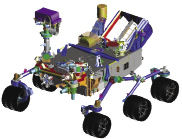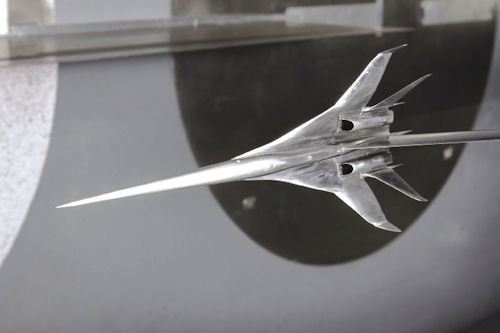July 1, 2013
 The NASA Jet Propulsion Laboratory used Siemens PLM Software’s NX and Teamcenter for its Mars Rover Curiosity. |
In May, Jim Phelan, Siemens PLM Software’s director of global public relations, found himself at the Collier Trophy presentation, sitting a few feet away from bona fide rocket scientists. He recognized one of them from NASA’s promotional video clip “Seven Minutes of Terror,” released just days before Curiosity Rover touched down on the Red Planet’s surface.
Named after air sports pioneer Robert J. Collier, the trophy marks “the greatest achievement in aeronautics or astronautics in America.” This year, the honor went to the NASA Jet Propulsion Laboratory’s (JPL) Mars Rover Curiosity project team.
“The reason we were there is because we provided the software—NX and Teamcenter—used to design, test, and simulate the Mars Rover Curiosity,” Phelan explains.
“I get the sense that small business participation in space exploration is increasing, particularly in the private sector,” Phelan says. The Google Lunar X Prize—a $30 million pod set aside for the first privately funded teams to safely land a robot on the surface of the moon, have that robot travel 500 meters over the lunar surface, and send video, images and data back to Earth—is also spawning a new generation of smaller, nimbler startups with lunar ambitions (Editor’s Note: For more, read “A New Space Race, Fueled by Simulation,” April 2013).
Last November, Siemens PLM Software acquired LMS, a test and mechatronic equipment supplier. LMS also happens to count NASA as one of its customers. The agency uses the company’s Virtual.Lab testing platform to verify the critical loading on giant rocket nozzles of launch vehicles, according to LMS.
High Speed at Low Boom
One of NASA’s high-speed initiatives took off quietly, in a manner of speaking. Peter Coen, who manages NASA’s supersonic project, explains, “We’re primarily working on technologies that help reduce the environmental impact of a supersonic airplane, reducing sonic boom, takeoff and landing noise and high altitude emissions. We’re also working on some technologies that help improve the efficiency and reduce the weight and drag of a supersonic aircraft. Our primary focus right now is on what we consider the toughest barrier to future supersonic aircraft, the sonic boom” (Source: NASA Edge podcast: “NASA Lowers the Sonic Boom,” Feb. 28, 2013).
The project involves three household names in aerospace: Gulfstream, Lockheed Martin and Boeing. But also in the mix is TRI MODELS, a wind tunnel model supplier based in Huntington Beach, CA.
Chris Athaide, TRI MODELS’ director of new business, says, “In 2011-2012, for NASA, we were part of the NASA Prime team working on supersonic low-boom testing and also N+2 ultra-high bypass engine/airframe integration. We designed and built various wind tunnel models, support systems and measurement devices used in numerous tests at NASA Ames and Glenn research centers.”
TRI MODELS was contracted to build the pressure rail systems—used to measure pressure signatures in sonic boom tests—for Gulfstream, Boeing, Lockheed and NASA. During conference calls and group discussions, it became clear to Athaide that TRI MODELS was expected not just to produce hardware on spec, but to provide input and participate in the project itself.
Athaide recalls, “So at one point, I told them, ‘You’re trying to measure pressure down to a very small increment, but your ]physical] wind tunnels were built roughly in the ’50s. They’re probably no longer in their ideal conditions. Yet in your wind tunnel modeling ]the digital replica used for computational fluid dynamics], you assume ideal conditions in geometry and flow field.” And that discrepancy could produce inaccurate results, he pointed out to his project liaisons.
With this compelling argument, TRI MODEL won an assignment to inspect the primary wind tunnel used in the project, and reproduce a digital model that matched the as-built conditions. “We gave them an accurate CAD model of the wind tunnel walls, based on measurements taken with laser trackers,” Athaide says. One of the notable features of the digital model produced by TRI MODELS is the surface geometry. They’re imperfect—because they reflect the real wind tunnel walls.
Athaide uses digital simulation routinely to verify and improve his designs, but he also cautions that there are certain phenomena digital simulation can’t easily detect. “For example, control reversal or roll oscillation. It’s something that happens during certain parts of a high-speed flight, but it’s not easily reproduced in simulation. It’s second-order or third-order phenomenon, but it occurs,” he says.
Making a Splash
Mahesh Patel has never been inside NASA’s Orion Crew Module, anticipated to be deployed in missions to the moon and Mars, but he can tell you by the numbers what it would feel like when it returns to Earth and makes a water landing. Patel is engineering manager for Altair ProductDesign, Altair’s engineering consulting division.
NASA has built a full-scale model of the Orion in boiler plates and steel reinforcements for testing. On a designated day, the prototype was hauled off to a freshwater lake, to be dropped numerous times at different angles. The impact data from the built-in accelerometers, strain gauges and inertial measurement unit was then recorded. Eventually, when NASA contracted Altair ProductDesign to replicate the physical tests in a computer-simulated environment, Patel and his colleagues would use what was recorded during the physical drops as their starting point.
According to Patel, NASA was looking to predict the exact load as the vehicle hit the water upon re-entry to Earth. This knowledge would help the agency design a crew module that could safely withstand the impact without serious structural damage. “A lot of assumptions were used in designing the crew module,” says Patel, “so they wanted to know if they were overdesigning it or under-designing it. They can do that with physical tests, of course, but that would be very expensive and time-consuming.”
To study the wide range of possible water landing scenarios, the agency would have had to conduct hundreds of physical drop tests at varying angles and velocities in a lake using actual crew modules—something much easier (and cheaper) to execute inside a computer-simulated environment.
“The crew module hitting the water is a very complex phenomenon,” Patel says. “NASA was actually trying to predict the pressures generated in the wave that would travel across the surface of the crew module ]of the vehicle]. Physically measuring those pressures accurately presents a challenge. Some of the pressure magnitudes and wave front speeds were surprising.”
 In 2012, NASA named TRI MODELS a Small Business Subcontractor of the Year for its work in the supersonic low boom project. The company specializes in supplying wind tunnel models to aerospace manufacturers. |
The project called for fluid-structure interaction simulation, to study the rigid vehicle’s contact with a body of water. To make the computer simulation realistic, Altair ProductDesign engineers needed to model not just the vehicle’s geometry, but also the water with correct interaction between the two properties. Patel and his colleagues used Altair’s HyperWorks software suite on this project; HyperMesh software to create the simulation models; and the RADIOSS solver to conduct the simulations.
The ProductDesign group was able to digitally replicate the vehicle’s water impact with near-identical results to NASA’s physical tests. This computer-driven simulation became a reliable basis for predicting what would happen to the crew module in the real world as it splashed into a lake at a certain speed and angle. For its work, the entire Crew Module team, including Altair ProductDesign, was honored by the NASA Engineering and Safety Center (NESC) with a group achievement award.
A Good Return on Our Tax Dollars
The companies featured in this article exemplify the public-private partnerships that will likely define NASA’s foreseeable future. Their experience shows NASA is looking for not just subcontractors to provide components and services, but collaborators to contribute counsel and domain expertise. Even smaller players’ footprints are in every aspect of the agency’s workflow, from conceptual design to simulation and testing. The agency’s success—from quieting the supersonic boom to landing the Curiosity Rover on Mars—is just as much the contractors’ victory.
In NASA Administrator Charles Bolden’s words, “Small business represents the best of the American spirit of innovation, the drive to solve problems and create solutions to our biggest challenges. We’re pleased to recognize the excellence of these entrepreneurs, whose work brings a great return on the taxpayer’s investment.”
Kenneth Wong is Desktop Engineering’s resident blogger and senior editor. Email him at [email protected] or share your thoughts on this article at deskeng.com/facebook.
More info
Subscribe to our FREE magazine, FREE email newsletters or both!
About the Author
Kenneth Wong is Digital Engineering’s resident blogger and senior editor. Email him at [email protected] or share your thoughts on this article at digitaleng.news/facebook.
Follow DE





